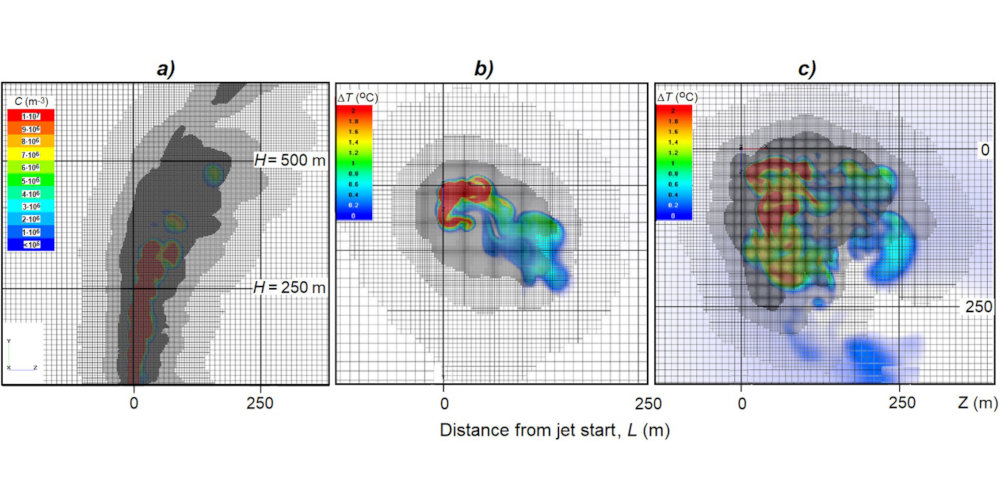В статье представлены результаты разработки математической модели и численного моделирования подъема в атмосфере вертикально направленной струи, питаемой теплотой конденсации водяного пара на гигроскопичном аэрозоле, введенном в струю на старте.
Оценена возможность создания искусственных конвективных облаков в зависимости от параметров струи, теплоты конденсации и вертикальных профилей скорости ветра, температуры и влажности воздуха. Численные эксперименты показали, что движение высокоскоростной высокотемпературной струи в атмосфере имеет сложную турбулентную природу. По мере подъема струя расширяется, теряя перегрев и скорость. Температура струи снижается быстрее скорости, поэтому струя поднимается несколько выше уровня, при котором исчезает ее перегрев. Высота подъема струи увеличивается по мере повышения влажности воздуха и вертикального градиента температуры. Ветер заставляет струю деформироваться, изгибаться и уменьшать высоту подъема. Насыщение струи гигроскопическим аэрозолем, приводящее к выделению теплоты конденсации, значительно увеличивает высоту подъема струи. Это особенно эффективно в случае введения в струю двухсоставного наноаэрозоля NaCl/TiO2, способного поглощать пары воды в количестве, значительно превышающем его массу. Результаты моделирования демонстрируют возможность создания искусственных восходящих потоков, которые могут привести к образованию конвективных облаков и выпадению осадков в дни с благоприятными атмосферными условиями, когда скорость ветра в подоблачном слое <6 м/с, влажность воздуха >65 %, а скорость падения температуры составляет > 7,5 °C/км.
Скачать PDF 9999KB (статья на английском языке)
This paper presents the results of the development of a mathematical model and numerical simulation of the ascent in the atmosphere of a vertically directed jet fed by the heat of condensation of watervapor on a hygroscopic aerosol introduced into the jet at the start.
The possibility of creating artificial convective clouds depending on jet parameters, condensation heat value and vertical profiles of windspeed, air temperature and humidity has been evaluated. Numerical experiments showed that the motion of a high‑speed and high‑temperature jet in the atmosphere has a complex turbulent nature. As the jet ascends, it expands, losing superheat and velocity. The temperature of the jet decreasesfaster than the velocity, so the jet rises slightly above the level at which its superheat disappears.The jet’s ascent height increases as the humidity of the air and the vertical temperature gradientincrease. Wind causes the jet to deform, bend, and decrease the height of ascent. Feed the jet withcondensation heat results in a significant increase in jet lift height. This is particularly effective in the case of introducing into the jet two‑layer NaCl/TiO2 nanoaerosol, which is capable of absorbing water vapor in an amount significantly greater than its mass. The simulation results are encouraging in the possibility of creating artificial updrafts that can lead to the formation of convective clouds and precipitation on days with favorable atmospheric conditions, when wind speed in the sub‑cloud layer is < 6 m/s, air humidity is > 65%, and the temperature lapse rate is > 7.5°C/km.
Magomet T. Abshaev1, Ali M. Abshaev1*, Andrey A. Aksenov5, Iuliia V. Fisher2, Alexander E. Shchelyaev2, Abdulla Al Mandous3, Youssef Wehbe3 & Reyad El‑Khazali4 Study of the Possibility of Stimulating Cloud Convection by Solar Radiation Energy Absorbed in an Artificial Aerosol Layer // Atmosphere 2023, 14(1), 86
(1) Hail Suppression Research Center “Antigrad”, 198 Chernishevsky Street, Nalchik 360004, Russia.
(2) Engineering Company TESIS, 18 Yunnatov str., 7th floor, office 705, Moscow 127083, Russia.
(3) National Center of Meteorology, P.O. Box: 4815, Abu Dhabi, UAE.
(4) Department of Electrical Engineering and Computer Science, Khalifa University of Science and Technology, P.O. Box: 127788, Abu Dhabi, UAE.
(5) Joint Institute for High Temperatures, Russian Academy of Sciences, 13 Izhorskaya st, Moscow 125412, Russia.
Open Access This article is licensed under a Creative Commons Attribution 4.0 International License. http://creativecommons.org/licenses/by/4.0/.
